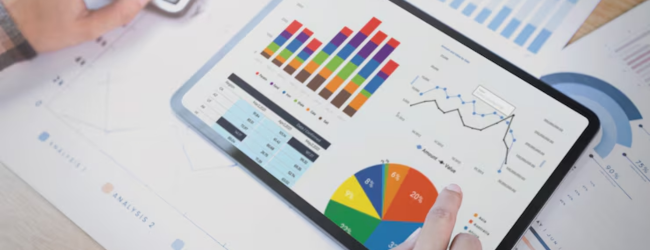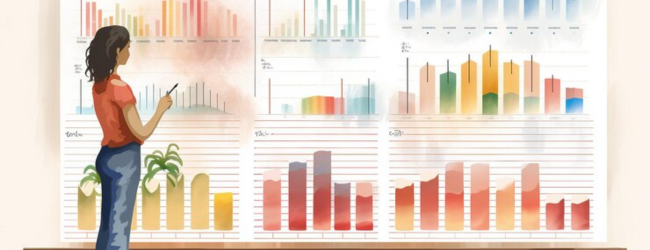Table of contents
- Defining Business Statistics: Transforming Data into Actionable Insights
- The Core Principles and Techniques of Business Statistics
- Types of Statistical Analysis
- The Indispensable Role of Business Statistics
- Illustrative Examples of Business Statistics in Action
- Statistical Software
- Need Expert Guidance?
- Conclusion
- FAQs
In today’s data-rich environment, businesses are constantly bombarded with information – sales figures, customer demographics, market trends, operational metrics, and much more. However, raw data, in its unorganized form, holds little intrinsic value. The key to unlocking its potential lies in the application of business statistics. This comprehensive guide will explore the fundamental question: what is business statistics? We will delve into its definition, core principles, essential techniques, and its indispensable role in empowering organizations to make data-driven decisions, optimize operations, and gain a competitive edge.
Defining Business Statistics: Transforming Data into Actionable Insights

At its core, business statistics is the application of statistical methods and techniques to collect, organize, analyze, interpret, and present data relevant to business operations and decision-making. It’s a specialized branch of statistics that focuses on providing practical insights and solutions to real-world business challenges. According to Coursera, it involves identifying patterns, trends, and relationships in data to support effective decision-making and solve business problems.
Think of business statistics as the bridge between raw, often complex, data and the strategic choices that shape a company’s future. It involves using quantitative methods to:
- Describe and Summarize Data: Providing meaningful overviews of key business metrics and characteristics.
- Identify Patterns and Trends: Uncovering underlying relationships and movements within business data over time.
- Make Inferences and Predictions: Drawing conclusions about larger populations based on sample data and forecasting future outcomes.
- Evaluate Performance and Identify Areas for Improvement: Assessing the effectiveness of strategies and pinpointing operational inefficiencies.
- Support Informed Decision-Making: Providing quantitative evidence to back up strategic choices and reduce uncertainty.
The Core Principles and Techniques of Business Statistics
Business statistics draws upon a wide array of statistical principles and techniques, broadly categorized into:
- Descriptive Statistics: These methods focus on summarizing and describing the main features of a dataset. Common tools include:
- Measures of Central Tendency: Mean (average), median (middle value), and mode (most frequent value) to identify the typical value.
- Measures of Dispersion: Range, variance, and standard deviation to understand the spread and variability of the data.
- Frequency Distributions: Tables and charts (histograms, bar charts, pie charts) to visualize the distribution of data.
- Measures of Shape: Skewness and kurtosis to describe the symmetry and peakedness of the data distribution.
- Inferential Statistics: These methods involve drawing conclusions and making generalizations about a population based on a sample of data. Key techniques include:
- Sampling Methods: Techniques like random sampling, stratified sampling, and cluster sampling to select representative subsets of data.
- Estimation: Using sample data to estimate population parameters (e.g., estimating average customer satisfaction based on a survey).
- Hypothesis Testing: Formulating and testing claims about a population based on sample evidence.
- Confidence Intervals: Providing a range of values within which a population parameter is likely to fall.
- Regression Analysis: Modeling the relationship between variables to predict future outcomes or understand causal effects.
- Correlation Analysis: Measuring the strength and direction of the linear relationship between two variables.
- Time Series Analysis: Analyzing data points collected over time to identify trends, seasonality, and cyclical patterns for forecasting.
- Probability Distributions: Understanding the likelihood of different events occurring.
💡 Pro Tip: If you want to start a business but have too many doubts, connect with a food business expert from Boss Wallah for guidance – https://bw1.in/1116
Types of Statistical Analysis

According to Coursera, statistical analysis can be further categorized into:
- Descriptive Statistical Analysis: Summarizes data without drawing conclusions. It often uses data visualization tools like graphs, tables, and charts.
- Diagnostic Statistics: Identifies why certain trends or outcomes occurred, using techniques like hypothesis testing and regression analysis.
- Predictive Statistics: Forecasts future trends and outcomes based on historical data, often using models and algorithms.
Data Visualization in Business Statistics
Presenting data clearly is crucial. Business statistics relies heavily on data visualization techniques, using charts, graphs, and other visual tools to communicate findings effectively.
The Indispensable Role of Business Statistics
In today’s competitive and dynamic business environment, the ability to leverage data effectively is no longer optional; it’s a fundamental requirement for success. Business statistics plays a crucial role in various aspects of business operations and strategic decision-making:
- Market Research and Analysis: Understanding customer behavior, identifying market trends, evaluating the effectiveness of marketing campaigns, and forecasting demand.
- Financial Analysis and Forecasting: Analyzing financial performance, assessing investment opportunities, managing risk, and predicting future financial outcomes.
- Operations Management: Improving efficiency, controlling quality, optimizing supply chains, managing inventory, and forecasting production needs.
- Human Resources Management: Analyzing employee performance, understanding employee satisfaction, predicting turnover, and optimizing recruitment strategies.
- Risk Management: Identifying potential risks, assessing their likelihood and impact, and developing mitigation strategies.
- Strategic Planning: Providing data-driven insights to inform strategic goals, resource allocation, and competitive positioning.
- Quality Control: Monitoring and improving the quality of products and services through statistical process control techniques.
- Decision Making Under Uncertainty: Providing a framework for evaluating options and making informed choices even when future outcomes are uncertain.
ALSO READ | What is Moment Marketing? Importance, Key Principles and Examples
Illustrative Examples of Business Statistics in Action
- A marketing team might use statistical analysis of sales data and customer demographics to identify their target audience for a new product.
- A finance department could use regression analysis to forecast future revenue based on historical sales trends and economic indicators.
- An operations manager might employ statistical quality control charts to monitor the consistency of a manufacturing process.
- An HR department could use statistical surveys to gauge employee satisfaction and identify areas for improvement.
- A retail company might use time series analysis to forecast seasonal demand for products and optimize inventory levels.
Statistical Software
Business statistics often involves using specialized software. Common tools include:
- Microsoft Excel
- SPSS
- R
- SAS
- Python (with libraries like Pandas and NumPy)
Need Expert Guidance?
Starting a business can be challenging, but you don’t have to do it alone! At Boss Wallah, our 2,000+ business experts are ready to provide valuable insights and guidance. Whether you need help with marketing, finance, sourcing, or any other area of any business, our business experts are here to help you succeed- https://bw1.in/1116
Confused about Which Business to Start?
Want to start your own business but unsure which one to choose? Explore Boss Wallah, where you’ll find 500+ courses by successful business owners, featuring practical, step-by-step guides on starting and growing various businesses.
Find your perfect business idea today – https://bw1.in/1111
Conclusion
Business statistics is far more than just numbers and calculations; it is a powerful toolkit that empowers businesses to transform raw data into actionable intelligence. By applying statistical methods, organizations can gain a deeper understanding of their operations, customers, and the market landscape. This understanding, in turn, leads to more informed decisions, optimized processes, reduced risks, and ultimately, a greater likelihood of achieving their strategic goals and thriving in the data-driven world. Mastering the principles and techniques of business statistics is an invaluable asset for any business professional seeking to drive growth and make a meaningful impact in their organization.
FAQs
- How does business statistics differ from general statistics?
- While both involve the collection, analysis, and interpretation of data, business statistics specifically focuses on applying these methods to address business-related questions and challenges.
- What are the two main branches of business statistics?
- The two main branches are descriptive statistics (summarizing data) and inferential statistics (making inferences and predictions).
- Why is data quality important in business statistics?
- The accuracy and reliability of statistical analysis heavily depend on the quality of the data used. Inaccurate or biased data can lead to flawed insights and poor decision-making.
- What are some common software tools used for business statistics?
- Popular tools include Microsoft Excel, SPSS, R, SAS, and Python with libraries like Pandas and NumPy.
- Can business statistics help small businesses?
- Absolutely. Even small businesses can benefit from using basic statistical techniques to track sales, understand customer trends, and make informed decisions about inventory and marketing.
- Is a strong mathematical background required to understand business statistics?
- While a basic understanding of mathematical concepts is helpful, the focus in business statistics is often on the application and interpretation of statistical results rather than complex mathematical derivations.
- How can businesses use statistics to gain a competitive advantage?
- By leveraging statistical insights into customer behavior, market trends, and operational efficiency, businesses can make smarter decisions that allow them to outperform their competitors.
- What is the role of data visualization in business statistics?
- Data visualization (using charts and graphs) is crucial for effectively communicating statistical findings and making complex data more accessible and understandable to a wider audience.


